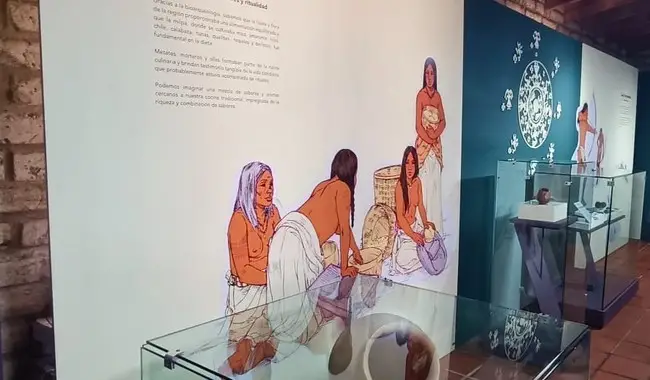
Images of a man and a woman with tattoos on their faces and forearms, former inhabitants of the foothills of the Sierra Madre Occidental, in the Guadiana Valley, welcome visitors to the La Ferrería Archaeological Site Museum in Durango, part of the museum network of the federal Ministry of Culture, through the National Institute of Anthropology and History (INAH), after the renewal of its scientific script and museography, which incorporated information from the last decade.
Part of this new data is the anthropophysical analysis carried out on bones recovered from the site, which today allow us to understand the possible physiognomy of its inhabitants, highlights the director of the Comprehensive Research Project of La Ferrería, Cinthya Vidal Aldana, commenting that years of research and excavations have allowed us to better understand their daily practices, rituals and ways of subsistence.
The museum has just reopened and offers a window into that past, revealing the life and culture of the region, an environment rich in natural resources thanks to the Tunal River, from which the Ayala Hill stands out with its two peaks, where the monuments of the pre-Hispanic ceremonial center are distributed.
The person in charge of the archaeological zone also adds that La Ferrería is one of the most important archaeological sites in northern Mexico, and its occupation dates back more than 1,000 years, with a complex society that maintained a strong connection with other cultures of what is now the southwest of the United States and Mesoamerica, between 600 and 1350 AD: southern Sinaloa, northern Nayarit and Zacatecas, the central coast of Sonora, and the mountains of Chihuahua.
Through information panels, 3D recreations, artistic illustrations and playful devices, the renovated museum offers a tour of three thematic axes, ranging from biological variability, activities and funerary traditions, to the themes called “Places and paths” and “Geography-World”, which explore the relationship of ancestors with their natural environment and their cosmogony.
The collection, says Vidal Aldana, brings together 120 artifacts including stone and ceramic tools, bone and shell pieces. Each one was selected for its ability to illustrate key aspects of life and culture in La Ferrería.
“There are vessels, stone, pigments, incense burners, etc., which come from excavations carried out from the 1950s to the present. Also, the iconography of the ceramics and the rock art that is displayed on the site are highlighted. We use these motifs on stamps so that the public can take home a souvenir.”
Regarding its ancient inhabitants, the study of bone remains and the environment has confirmed particular physical characteristics: Men, on average, were 1.70 meters tall, considerably tall for the time. They had thin arms and torsos, with marked muscles and dark skin. Their faces were medium and wide, and their legs had an athletic build, the result of hunting and food gathering.
In turn, women were 1.60 meters tall, on average, and had graceful features. They had particular muscles in their arms and legs, especially in the instep, a characteristic developed by physical work when grinding seeds and grains on the metate, which were a fundamental part of their diet.
Both sexes usually wore their torsos bare and wore loincloths. Long, black, straight hair was a symbol of status and good health in Amerindian communities. Women wore it in hairstyles rolled to the sides or in braids. The attire was complemented by ornaments such as copper earrings with hanging shells and bead necklaces made of colorful stones, ceramics, bone and shell.
They also had tattoos, whose symbols and patterns were part of an iconography linked to their cosmological system. These attires reflected the identity and connection of the people with their culture and beliefs, which was interpreted by local illustrators Paulina and Daniela Ortega Contreras.
The museum also shows the construction of houses, temples and other buildings of a ritual nature, such as the sunken patio and the ball court. As archaeologist Cinthya Vidal Aldana explains, the settlement began around 600 AD. The pyramidal foundations and the ball court were built between that date and 750 AD. The following construction phases occurred between 750-900 AD and 900-1100 AD.
With an inclusive design, which provides resources for people with different access to information in terms of language, route and experience, the La Ferrería Site Museum awaits visitors from Tuesday to Sunday, from 9:00 a.m. to 5:00 p.m.
Source: gob






